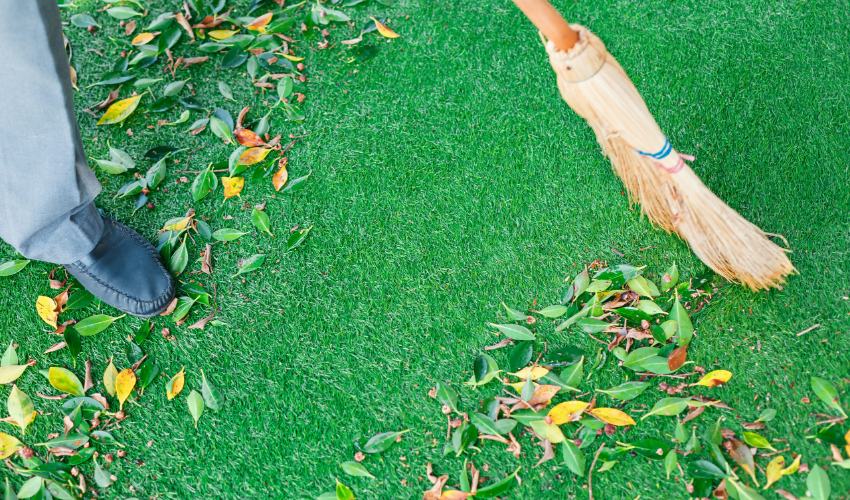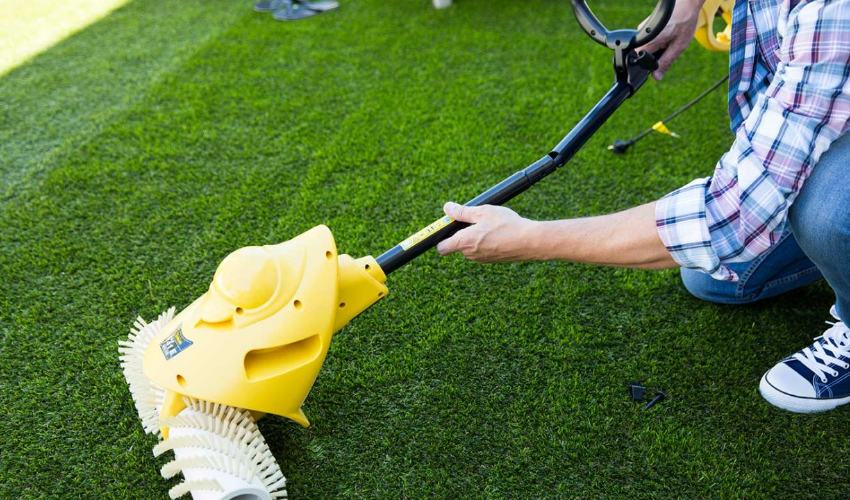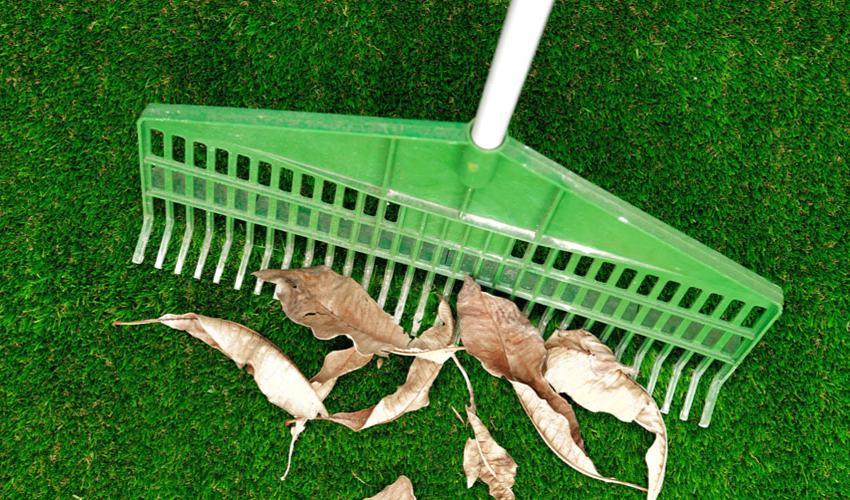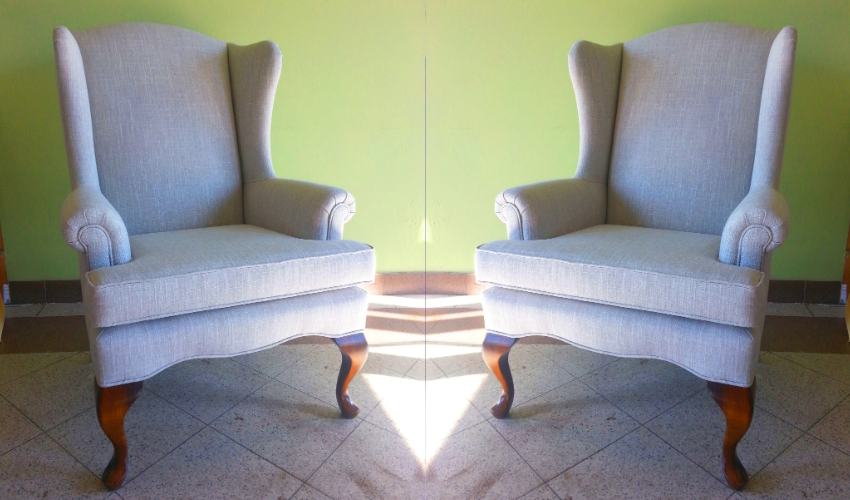Proper cleaning and maintenance of artificial grass is necessary to extend its life. Maintaining the appearance and hygiene of fake grass becomes quite challenging with kids and pets at home. However, it is easy to aftercare this low-maintenance turf compared to natural grass.
This grass is primarily constructed using different synthetic materials, featuring different sensitivities against intense wear and tear. That’s why, you must be careful when it is a DIY fake grass cleaning project. In this guide by Green Grass, we’ll show you how to keep your turf well-maintained all year round by following the simple steps and tips.
Different Methods To Clean Artificial Grass

To prevent the growth of mold, mildew, weeds, and other substances, it is necessary to not leave your fake turf unattended over time. That’s because, these contaminants when embedded in fibers can result in discoloration, damage, and unhygienic conditions. Here’s why, we’ve added some effective synthetic-grass cleaning strategies.
Required Tools And Materials
Make sure, you’ve all these essential equipment and supplies handy before initiating the cleaning process.
- Stiff Broom & Rake
- Soft Bristle Brush
- Leaf Blower
- Mild Detergent
- Fake Grass Cleaner
- Garden Hose
- Stain Remover
- Sponge Or Microfiber Cloth
Cleaning Methods

Our take on how to clean artificial grass at home begins with these simple steps;
1. Regular Cleaning
The cornerstone of maintaining this turf is preserving its functionality and appearance which can be done by regular cleaning. Establish a weekly, monthly, and annual cleaning routine to keep your grass dirt, stain, and germ-free year round. For regular cleaning, use a soft brush to broom and remove the dirt and debris with a leaf blower
2. Spot Cleaning
In addition to regular cleaning, prompt action of spot cleaning is crucial if any accidental spills happen. Wipe off any drink, coffee, and paint splashes from the surface instantly using a sponge and microfiber cloth. Also, spray the cleaning solution to remove any leftover and stain from the surface. For oily stains, you can use mineral spirits or bleach-free detergents.
3. Hosing And Watering
Hosing and watering are needed to remove the pet waste from your fake grass carpet. If the pet dropping is still wet, you can use the pressure spray on your hose to remove it. However, to remove the solid waste, use a pet waste bag and simply scoop up the dropping. Then follow it with a wash of soapy solution so that the unpleasant odor will fade away. Also, a deodorizer of mild composition can be used to neutralize the odor.
4. Deep Cleaning Using Solutions & Chemicals
Deep cleaning using homemade and commercial cleaners is another effective way to keep this grass clean and well-looking year-round. Make a water, soap, and vinegar solution, or use commercial liquid-based detergent to pour on the entire fake grass surface. Use a brush softly to remove stubborn stains, greasy substances, and accumulated dirt.
Cleaning Techniques For The Specific Types Of Artificial Grass

This is crafted using polyethylene, polypropylene, and nylon materials, varying in terms of looks, durability, and usage extent. If you are looking for tips on how to maintain artificial grass based on the specific fiber heights and face weight, here are the tips for you.
1. Short-Pile Grass
Short-pile grass features a height of about 18-25mm, offering easy cleaning and maintenance schedules. For the occasional grooming of this low-pile grass for the wall, you simply need to manage the surface dirt and debris and wet the grass thoroughly with water. Apply the diluted solution and rinse the loosen dirt with clean water.
2. Long-Pile Grass
High-pile grass is more likely to trap dirt, hairs, fallen leaves, and other environmental contaminants. You need to thoroughly brush their fibers to keep them in an upright manner. Also, they require deep cleaning with a pressure washer and chemical detergents to ensure the properly cleaned surfaces.
3. Textured Grass
For the textured grass, you need to use the stiff broom as it will help keep the blades straight and prevent matting. Like high-pile turf, it also requires deep rinsing at least once a week or twice a month to keep the dirt and pollen at bay, inhibit weed growth, and keep the bad odor of the pet’s urine at bay.
4. Colored Grass
Upkeep of colored grass requires special attention when using commercial detergents. To protect the blades against discoloration, you must prevent harsh and abrasive-based cleaners. In addition, apply the weed killer to inhibit their growth.
Regular Maintenance & Upkeep Tips For Synthetic Turf

Some maintenance and cleaning of artificial grass tips are explained here to help you with the best usage, securing your investment for a long, and extended lifespan.
1. Establish Proper Cleaning Routine
Clearing the debris, spot cleaning stains, and removing the pet’s excretion spontaneously greatly contribute to keeping your fake turf fibers in good shape and appearance for so long. Make sure to do rinsing weekly, monthly, annually, and professionally for fake turf’s longevity.
2. Occasionally Disinfecting
The best way to clean fake grass is to sanitize it occasionally to maintain a health-friendly and hygienic environment. Areas that experience high foot and pet activity must be sanitized using an anti-bacterial solution to eliminate the fungus and harmful substances.
3. Monitoring Drainage Issues
Check any signs of standing water and clogged drains weekly to ensure the proper water flow through the perforated system. If the drainage channel is blocked due to debris accumulation, remove these waste products using a stiff broom or plastic rake.
4. Prevent Discoloration
To keep this grass sustained against discoloration, look for any mirrored surfaces like reflecting windows. Either cover the windows with some fabrication or install an awning to protect the fibers against fading from harsh UV exposure.
5. Matting And Tangling
Brushing and raking is the ideal way to keep your fake grass fibers protected against matting and tangling. Prefer the rake with plastic prongs rather than metal to avoid any kind of potential damage to the surface.
6. Address Weed & Moss Problems
To tackle the weed and moss issues, inspect the corners and edges. After you find any weed grown in seams, pull it using your hands. Also, you can use mild herbicides to get rid of them. To eliminate the moss, a diluted solution is enough.
7. Check and Replenish Infill
As the infill supports the grass blades, you must check for its level on the surface. If it is diminished or compacted from the surface, it will cause the fiber to wear out soon. Make sure to add more infill for extraordinary support, turf resilience, and drainage capabilities.
In The End!
Artificial grass maintenance and cleaning is the ideal solution to sustain their shape and effectiveness for long spans. Fake turf is built using different synthetic materials and requires precocious cleaning and maintenance according to their fiber’s height and resilience. To keep the stains, dust, and debris at bay, it is suggested to regularly and spot-clean your grass.
Also, you must deep clean them weekly or monthly to avoid the build-up of dirt and dust. Get rid of your pet’s mess and address any drainage issues instantly. In addition to that, you must get artificial grass cleaning services at least once a year to keep them looking well-maintained for years on end. By following the simple tips and methods in this article, you can keep synthetic turf in the best condition.










